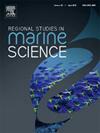巴西暴露在上升流中的岩礁鱼类和避风岩礁鱼类的体外寄生虫感染水平不同
IF 2.1
4区 环境科学与生态学
Q3 ECOLOGY
引用次数: 0
摘要
寄生虫在海洋生态系统中无处不在,数量庞大,它们发挥着重要的生态作用,如影响宿主的种群动态、改变物种间的竞争以及影响群落中的能量流动。寄生虫的多样性和种群动态明显受季节和地理变化的影响。这些变化通常是在广阔的空间范围内进行的。然而,即使在较小的空间尺度上,寄生虫群落也会受波浪暴露、温度波动和底栖生境组成等因素的影响而表现出显著的差异。我们在巴西 Arraial do Cabo 研究了鱼类的甲壳类寄生虫--鳕形目(caligids)和鮨形目(gnathiids)--在两个仅相隔几公里的不同栖息地之间的差异。这两个栖息地的特点是有遮蔽的河口(以下简称 "内")或暴露的上升流栖息地(以下简称 "外")。我们在这两种生境中对四种鱼类的个体进行了研究。我们发现,不同种类鱼类的鞘翅目昆虫侵扰率不尽相同,两个取样地点的鞘翅目昆虫侵扰率也不尽相同。堤外的鱼类身上没有蚋,而堤内的鱼类身上却有蚋。这种差异表明,当地环境因素在影响钩吻鳉分布方面起着关键作用。潜在的驱动因素包括温度波动、底质成分和波浪曝露,这在两个地点之间存在明显差异。相反,两地的鱼类都感染了鞘翅目寄生虫。虽然环境因素也可能影响鳍鳃亚纲寄生虫的数量,但与嘬鳃亚纲寄生虫相比,鳍鳃亚纲寄生虫似乎表现出更强的耐受性。这些发现强调了在研究寄生虫分布模式时纳入细尺度环境异质性的重要性。本文章由计算机程序翻译,如有差异,请以英文原文为准。
Ectoparasite infection levels differ between fish from upwelling-exposed and sheltered rocky reefs areas in Brazil
Ubiquitous and abundant within marine ecosystems, parasites play essential ecological roles such as shaping host population dynamics, altering competition between species, and influencing energy flows through communities. Their diversity and population dynamics are demonstrably shaped by both seasonal and geographic variations. These variations have been often explored at broad spatial scale. However, parasite communities can exhibit significant disparities even at small spatial scales, driven by factors such as wave exposure, temperature fluctuations, and benthic habitat composition. We investigated how crustacean parasites of fish – caligids and gnathiids - differed between two distinct habitats, which are separated solely by a few kilometres, at Arraial do Cabo, Brazil. These two habitats are characterised by a sheltered embayment (hereinafter referred to as “inside”) or an exposed upwelling habitat (hereinafter referred to as “outside”). Individual fish from four species were examined in both habitats. We found that the infestation rate of caligids varied among fish species and, gnathiids varied between the two sampling sites. Gnathiids were absent from fish outside, while they were present on fish inside the embayment. This disparity suggests a critical role of local environmental factors in shaping gnathiid distribution. Potential drivers include temperature fluctuations, substrate composition, and wave exposure, which differed markedly between the two sites. Conversely, caligid parasites infected fish in both locations. While environmental factors may also influence caligid abundance, they appear to exhibit greater tolerance compared to gnathiids. These findings emphasize the importance of incorporating fine-scale environmental heterogeneity when investigating parasite distribution patterns.
求助全文
通过发布文献求助,成功后即可免费获取论文全文。
去求助
来源期刊

Regional Studies in Marine Science
Agricultural and Biological Sciences-Ecology, Evolution, Behavior and Systematics
CiteScore
3.90
自引率
4.80%
发文量
336
审稿时长
69 days
期刊介绍:
REGIONAL STUDIES IN MARINE SCIENCE will publish scientifically sound papers on regional aspects of maritime and marine resources in estuaries, coastal zones, continental shelf, the seas and oceans.
 求助内容:
求助内容: 应助结果提醒方式:
应助结果提醒方式:


